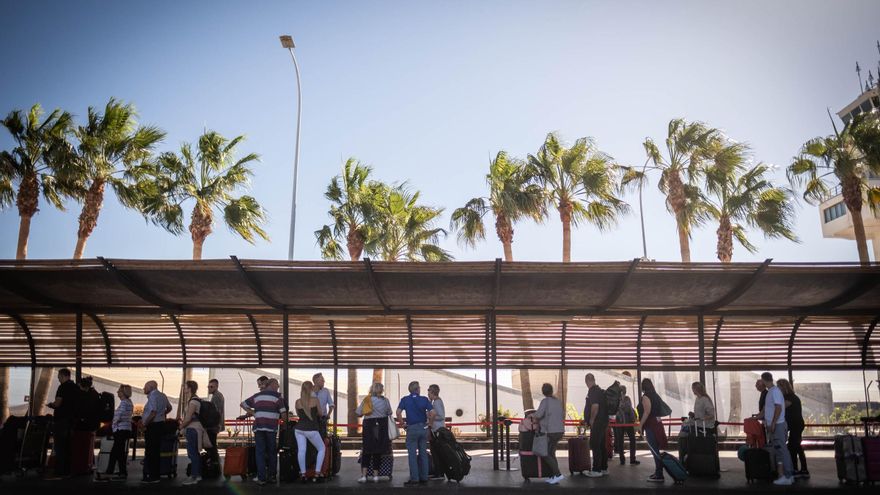
Immediate action is necessary to avert the congestion that Canarian airports typically endure, which risks escalating into complete saturation. This is a collective appeal from both the prominent employers of the Archipelago and the tourism entrepreneurs of Tenerife and Lanzarote — the two islands whose airports are operating at the brink of their capacity. They are directing this message to Aena and, by extension, to the Ministry of Transport and Sustainable Mobility.
Binter had cautioned back in November about the looming “saturation” of the Islands’ airspace. Should there be no intervention, the airline’s general coordinator, Santiago Guerra, warned that tourist arrivals would inevitably be affected. At that time, it was already anticipated that the airport network would conclude 2024 with a new record for passenger numbers. Indeed, the eight island airports accommodated over 50 million travellers last year, achieving this milestone for the first time in one year. However, this achievement also comes with a side B — greater congestion at airports, exposing their deficiencies. Both Lanzarote and Tenerife North airports are nearing their maximum capacity, while Tenerife South airport has displayed scenes inappropriate for a global tourism leader like the Canary Islands. Therefore, it is critical that preventive measures are put in place and that any necessary investments and construction work are carried out. As Pedro Ortega, president of the Canary Islands Confederation of Entrepreneurs (CCE), reminded on Wednesday, “we are not discussing trivial matters; we are talking about the gateway for our tourists and consequently, our income.”
The counterpart to Pedro Ortega at the Provincial Confederation of Entrepreneurs of Santa Cruz de Tenerife (CEOE-Tenerife) — as the CCE and CEOE-Tenerife together comprise the region’s largest employers’ association — recalls the lengthy queues of tourists recently witnessed at Tenerife South airport, either for passport control or simply to hail a taxi. “It is clear that enhanced access, a new terminal, and a second runway are essential”; moreover, the CEOE-Tenerife president explains that it is vital “until the car rental provisions improve.” While this issue is prevalent in Tenerife South, Tenerife North also faces challenges. In fact, the Los Rodeos airfield recorded more passengers between January and November 2024 — 6.19 million — compared to all of 2023 — 6.12 million, making it almost certain, pending December figures, that it surpassed its capacity, which Aena itself sets at 6.5 million annual travellers.
We are not discussing trivial matters; we are talking about the gateway to our income
Pedro Ortega
— President of the Canarian Confederation of Entrepreneurs (CCE)
Thus, it is hardly surprising that in light of the incident on the 2nd at Tenerife South airport, where a private jet experienced landing difficulties prompting a runway closure and the diversion of over twenty flights — necessitating their transfer to Gran Canaria, Fuerteventura, and Lanzarote — the already overwhelmed Los Rodeos airport could not accommodate all flights. “Not even having double infrastructure [Tenerife is the only island to feature two aerodromes] provides us solutions,” insisted Alfonso.
Conditions in Lanzarote are similarly challenging. The César Manrique airport experienced over 8.2 million passengers in 2024, exceeding the total for 2023, which puts it at 92% of its operational capacity. This occurs within a “quite outdated” setup, as highlighted by Susana Pérez, president of the Association of Hotel and Tourist Apartment Business Owners of Lanzarote (Asolan). “At the time, Aena prioritised internal reforms in commercial areas, which positively affects revenue but eliminated waiting space, and we must remember that most of our visitors are families,” Pérez illustrates. The Asolan representative argues that there is a requirement for more space in both the arrivals and departures areas, as well as at passport control, where workloads have increased since Brexit with the need to stamp British passports. Furthermore, the airport’s master plan was approved “lately,” when “it should have been completed a decade ago.” The reality now is that the long-anticipated expansion of Lanzarote’s infrastructure is “overdue,” and Asolan hopes that Aena will take this into consideration for both the preliminary project — expected to be ready by June — and subsequent initiatives.
Nevertheless, there are necessities across the network, which will only become more urgent as tourist numbers increase. Consequently, it is crucial to anticipate these issues, a sentiment echoed by both Ortega and Alfonso on Wednesday. It is also worth noting that the Gran Canaria airfield, the largest in the region, registered over 14 million passengers in 2024 for the first time — thus, while it still has capacity to expand — 20 million, the gap continues to close. As the CCE president elucidates, it’s no longer merely a question of avoiding pushing the airport network to its limits; it’s increasingly important that both locals and tourists have a positive experience at the airfields and “do not encounter a poor experience as a result.”
A new DORA
The Hotel and Non-Hotel Association of the province of Tenerife (Ashotel) has been advocating for the addition of a new terminal for Tenerife South airport in the DORA, the document outlining Aena’s investment strategy. This demand has resurfaced due to the significant queues of tourists at Tenerife’s airfield. Discussions regarding the next DORA are set to commence in 2025, with the regional government already planning meetings with the councils to identify investment needs.
Subscribe to continue reading
















